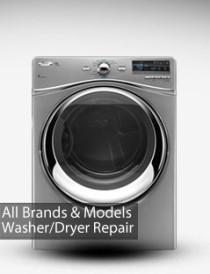MORE ABOUT YOUR DRYER
Drum drive system typical of many dryers uses a belt through a spring-loaded idler pulley to maintain the necessary tension.
Dryer air flow, dryer heat, and dryer tumbling combine to dry garments.
The heated air, passing through small holes into and out of the revolving dryer drum, picks up dryer moisture on its way through the clothing. Passing through the lint trap, the moisture-laden dryer air returns to the dryer blower, which forces it out the exhaust duct. A thermostat in the trap duct turns the heaters on and off to control the temperature of the air. Thermostat action now starts the heat source, but turns on the timer motor. The dryer timer knob advance slightly until the thermostat again turns on the heat source. After a number of these cycles, which increase in time and length of heat-off time, the timer cams have advanced positions of the dryer timer contacts. Until now, the dryer thermostat has controlled the actions of the heat source and the timer motor. Now the limey takes command. The dryer heat source is turned off, and the timer keeps the timer motor energized to advance the timer. In his is the cool-down period, and only the motor, fan, and timer is a live for the few minutes before shutoff. The latest in dryer control systems, and the most accurate means this is the electronic control. This uses the wet clothing in the dryer drum of the circuit. Sensing dryers are built into the revolving drum. A dryer drum consists of two metal bands that run around the inside of the drum. Another is an insulated plastic block, containing several copper fingers, fastened to the rear of the drum. In these units, the rear of the drum is stationary. This eliminates the problem of using slip rings to complete the circuit to a sensor that is moving with the. As the dryer drum revolves, clothes are jostled and tossed against these sensors. Each time a piece of wet laundry completes the circuit across file contacts, the dryer is held on for a few seconds. As the clothing drying, resistance to electric-current flow increases. Finally, this reaches a point at which it triggers a circuit that sends the signal into "cool-down." A fixed thermostat controls heat at a moderate during the entire cycle to continue turning the drum and the blower without heat. This period lets the clothing cool before tumbling ceases, making handling easier and reducing the possibility of setting wrinkles in the clothing. The time temperature method of controlling a dryer is reliable, but it leaves much to guesswork. With the trend in recent years to clothing made from synthetics, which are much more sensitive to over drying, it became evident that a better method was needed. A more accurate means of control was found in what is commonly called the automatic control method.
Common Dryer
Problem:
Dryer Not Heating:
Gas Dryer -
Gas Dryers are really big on airflow. Before calling a service company out to
service your gas dryer here are a few tips that may save you some money.
- Check the lint screen (It seems simple, but yet I have seen several gas dryers where
the lint was caked up thick on the lint screen) - Check vent hose, The easiest way to do this is to turn your dryer on, go outside and put
your hand next to the exhaust vent line. Is the air blowing strong? Or can you barely
feel a thing. If the airflow is weak, try putting your hand in the vent line and cleaning out
any buildup that may be present. It may also be necessary to pull the gas dryer out
and disconnect the vent line to clean throughly. - If all else fails and you are still having trouble with your gas dryer heating please feel
free to contact us.
Electric Dryer - Electric dryers are also big on air flow so follow the same steps as gas dryers
listed above. - A common complaint with electric dryers is that they will turn but not heat. If your lucky
it is just a blown fuse at the breaker box. Electric dryers run on 220 volts of juice
instead of 110 volts which means Electric dryers have two breaker switches. One of the
breakers can flip causing a "no heat" problem. It still gets 110 volts letting the dryer
seem so run just fine but it needs that extra 110 juice for the heating element to work! - If that fails to be your problem you will need to contact us as the
machine will need to be taking apart to find the problem.
Dryer Not Turning:
- Gas or Electric dryers; Either broken Belt or thermostat/thermal fuse. We suggest
contacting us for this repair.
Gas Dryer Has Weird Smell?
- Have you recently painted your house or done some sort of work to your floors? For
some reason gas dryers love to suck in all those chemicals and burn the smell right into
your clothes. Open your windows to vent your house, you will be stuck with the smell
for a few weeks. - If not the above, you may have a gas leak... Once again this would be a job for us.






